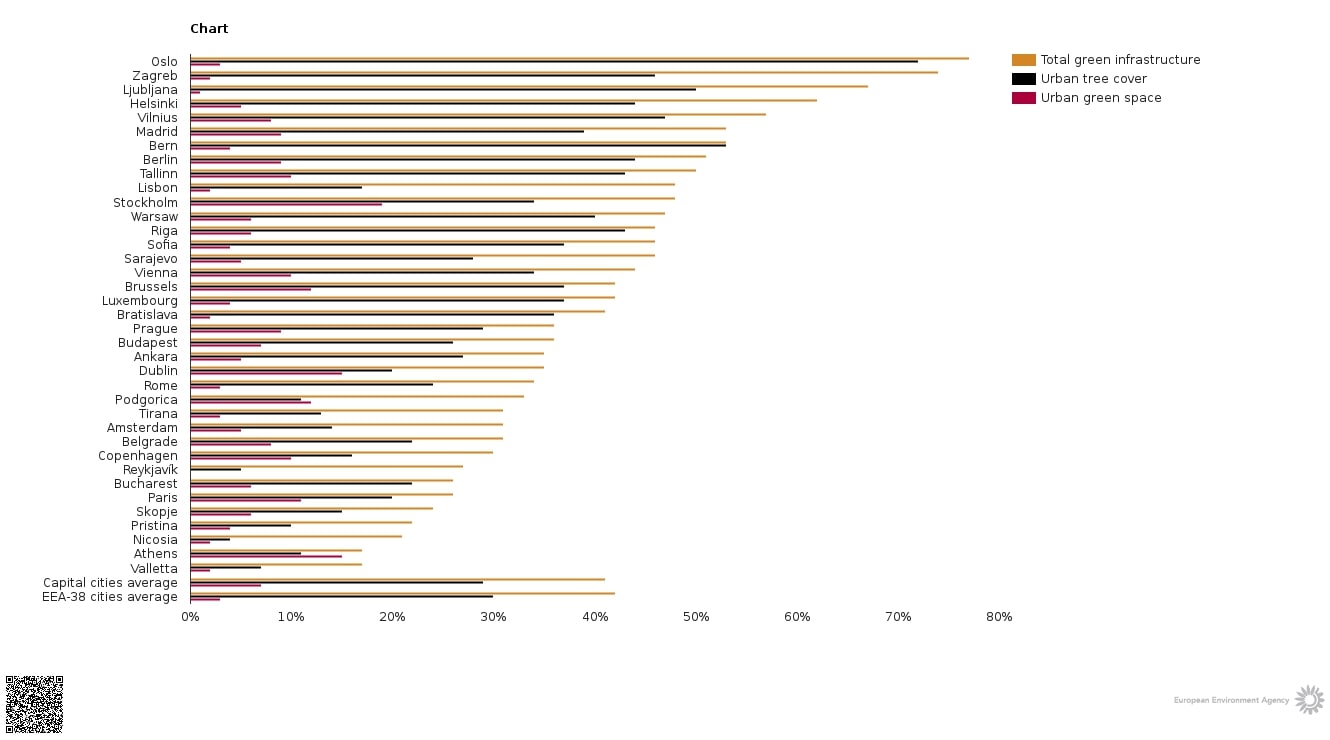Thessaloniki gets ready for its metro launch in November
The underground rapid transit lines have been under construction for almost two decades due to various project delays
 TheMayor.EU logo
TheMayor.EU logo The European Environment Agency shows that public access to greenery is still out of reach for many
At the start of this month, the European Environment Agency released a briefing that summarized the state of greenery in the continent’s cities. The study looked at total green infrastructure, comprised of urban spaces and total tree coverage.
The study found that cities in the north and west of Europe tend to have more green space than cities in the southern and eastern regions of the continent. The assessment looks at socio-economic and demographic inequalities in access to green and blue spaces in European cities.
The study covered 38 countries from the European Economic Area (also EEA, though not to be confused with the Agency’s abbreviation). In terms of capital cities, Oslo (Norway) is the greenest and Valletta (Malta), the least so.

The ranking of European capital cities in terms of total green infrastructure.
Source: European Environment Agency
What was immediately apparent, as well, was that answering which city was the greenest and how green they are might be questions that have no easy, straightforward answers. In fact, the answers come with certain caveats.
For example, the city with the highest proportion of total green space (96%) is Cáceres, in the southwest of Spain. This may come as a surprise to many, given the southern location of that city.
The reality is that the administrative area of Cáceres is very large. It incorporates natural and semi-natural areas which surround the actual inhabited core. On the other hand, the city with the lowest total green space is Trnava (Slovakia) with only 7%.
Another thing that we have to take into consideration is that not all of the green spaces are publicly accessible. In fact, the situation is fairly dismal if we only take into account that dimension. On average in the EEA, only 3% of the total city area belongs to publicly accessible greenery. This varies between cities, with cities such as Geneva (Switzerland), The Hague (Netherlands) and Pamplona (Spain), seeing accessible green spaces account for more than 15% of the city area.
Another indicator that the EEA has looked at is the average urban tree cover, which stood at 30% for the 38 countries. Cities in Finland and Norway have the highest proportion of tree cover, while cities in Cyprus, Iceland and Malta, the lowest.
Across Europe, green space is less available in lower-income urban neighbourhoods than in higher-income ones, with differences often driven by the housing market, where properties in greener areas are more expensive.
While the World Health Organization recommends that all people reside within 300 metres of green space, less than half of Europe’s urban population actually do. National and local guidelines vary across Europe and guidance on how to make access equal across social groups is rare.

The underground rapid transit lines have been under construction for almost two decades due to various project delays

Now you can get your wine in Talence by paying directly in Bitcoin

That’s because the state has to spend money on updating the railway infrastructure rather than subsidizing the cost of the popular pass

Rethinking renewable energy sources for the urban landscape

The examples, compiled by Beyond Fossil Fuels, can inform and inspire communities and entrepreneurs that still feel trepidation at the prospect of energy transition

Now you can get your wine in Talence by paying directly in Bitcoin

The 10th European Conference on Sustainable Cities and Towns (ESCT) sets the stage for stronger cooperation between the EU, national and local level to fast track Europe's transition to climate neutrality.

At least, that’s the promise made by the mayor of Paris, Anne Hidalgo

The underground rapid transit lines have been under construction for almost two decades due to various project delays

At least, that’s the promise made by the mayor of Paris, Anne Hidalgo

Hostal de Pinós is located in the geographical centre of the autonomous region

Despite its church-y name, the district has long been known as the hangout spot for the artsy crowds

Urban dwellers across the EU are having a say in making their surroundings friendlier to people and the environment.

Forests in the EU can help green the European construction industry and bolster a continent-wide push for architectural improvements.

Apply by 10 November and do your part for the transformation of European public spaces

An interview with the Mayor of a Polish city that seeks to reinvent itself

An interview with the newly elected ICLEI President and Mayor of Malmö

A conversation with the Mayor of Lisbon about the spirit and dimensions of innovation present in the Portuguese capital














